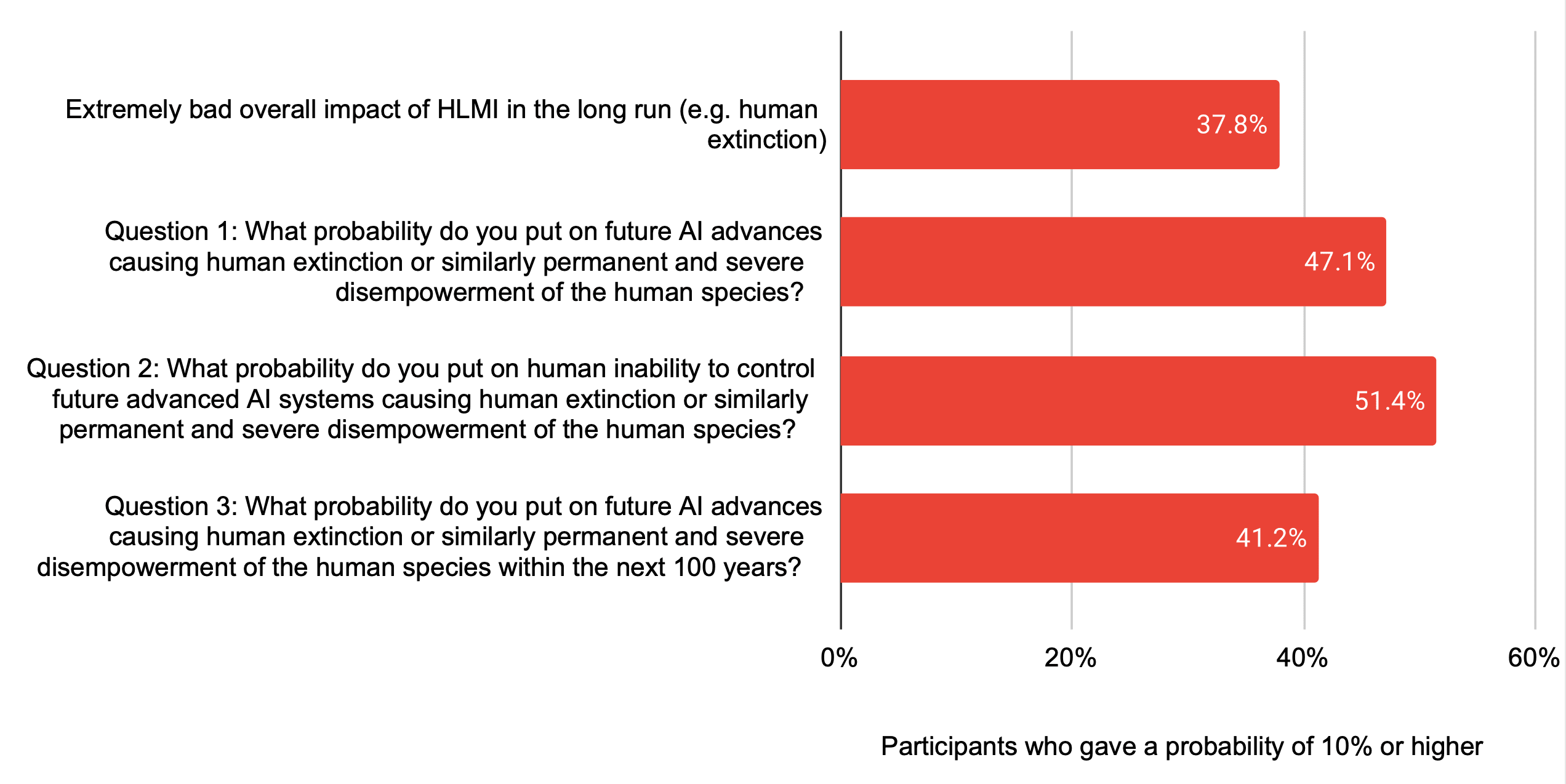AI Impacts 2023 Expert Survey on Progress in AI
post by habryka (habryka4) · 2024-01-05T19:42:17.226Z · LW · GW · 2 commentsThis is a link post for https://wiki.aiimpacts.org/ai_timelines/predictions_of_human-level_ai_timelines/ai_timeline_surveys/2023_expert_survey_on_progress_in_ai
Contents
Results Timing of human-level performance High-level machine intelligence (HLMI) Full automation of labor (FAOL) Intelligence explosion Chance that the intelligence explosion argument is about right Probability of dramatic technological speedup Probability of superintelligence AI Interpretability in 2028 How concerning are 11 future AI-related scenarios? Overall impact of HLMI Preferred rate of progress How soon will 39 tasks be feasible for AI? The alignment problem "Do you think this argument points at an important problem?" "How valuable is it to work on this problem today, compared to other problems in AI?" "How hard do you think this problem is compared to other problems in AI?" How much should society prioritize AI safety research? Human extinction None 2 comments
AI Impacts just released the results from their latest survey! I've found this quite interesting to engage with. Here is the results section of the linked wiki page:
Results
The full dataset of anonymized responses to the survey is available here.
Timing of human-level performance
We asked about the timing of human-level performance by asking some participants about how soon they expect “high-level machine intelligence” (HLMI) and asking others about how soon they expect “full automation of labor” (FAOL). As in previous surveys, participants who were asked about FAOL tended to give significantly longer timelines than those asked about HLMI.
High-level machine intelligence (HLMI)
Say we have ‘high-level machine intelligence’ when unaided machines can accomplish every task better and more cheaply than human workers. Ignore aspects of tasks for which being a human is intrinsically advantageous, e.g. being accepted as a jury member. Think feasibility, not adoption.
For the purposes of this question, assume that human scientific activity continues without major negative disruption.
Half of the participants were asked about the number of years until they expected a 10%, 50%, and 90% probability of HLMI existing (fixed-probabilities framing) and half were asked about the probability they would give to HLMI existing in 10, 20, and 40 years (fixed-years framing).
We aggregated the 1714 responses to this question by fitting each response to a gamma CDF and finding the mean curve of those CDFs. The resulting aggregate forecast gives a 50% chance of HLMI by 2047, down thirteen years from 2060 in the 2022 ESPAI.

Full automation of labor (FAOL)
Say we have reached ‘full automation of labor’ when all occupations are fully automatable. That is, when for any occupation, machines could be built to carry out the task better and more cheaply than human workers.
As with the HLMI question, half of the participants who were given the FAOL question were asked using the fixed-probabilities framing and the other half was asked using the fixed-years framing.
The 774 responses to this question were used to create an aggregate forecast which gives a 50% chance of FAOL by 2116, down 48 years from 2164 in the 2022 ESPAI.
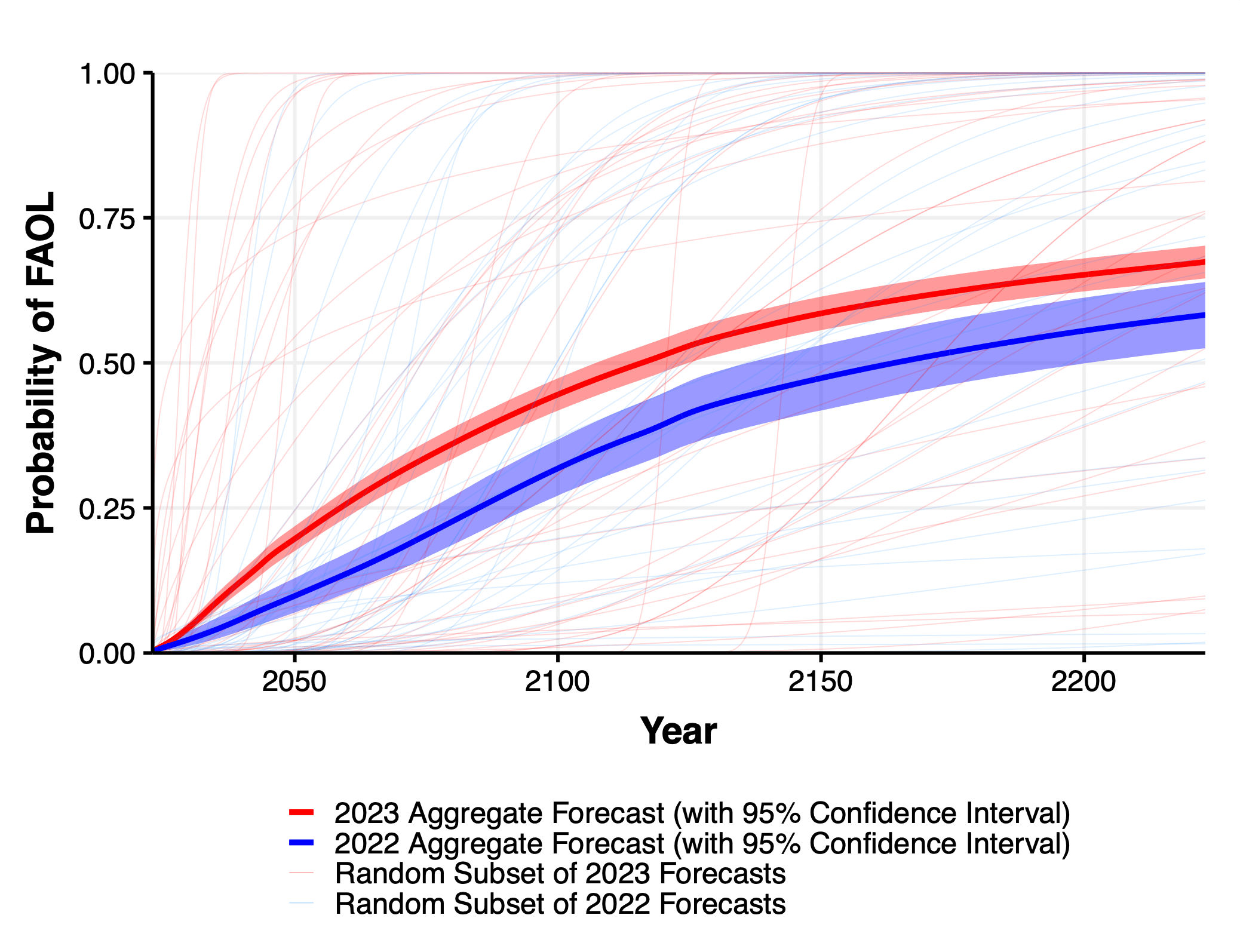
Intelligence explosion
We asked about the likelihood of an 'intelligence explosion' by asking each participant one of three related questions.
Chance that the intelligence explosion argument is about right
Some people have argued the following:
If AI systems do nearly all research and development, improvements in AI will accelerate the pace of technological progress, including further progress in AI.
Over a short period (less than 5 years), this feedback loop could cause technological progress to become more than an order of magnitude faster.
How likely do you find this argument to be broadly correct?
Of the 299 responses to this question,
9% said “Quite likely (81-100%)”
20% said “Likely (61-80%)”
24% said “About even chance (41-60%)”
24% said “Unlikely (21-40%)”
23% said “Quite unlikely (0-20%)”
Probability of dramatic technological speedup
Assume that HLMI will exist at some point.
How likely do you then think it is that the rate of global technological improvement will dramatically increase (e.g. by a factor of ten) as a result of machine intelligence:
Within two years of that point? _% chance
Within thirty years of that point? _% chance
There were 298 responses to this question. The median answer was 20% for two years and 80% for thirty years.
Probability of superintelligence
Assume that HLMI will exist at some point.
How likely do you think it is that there will be machine intelligence that is vastly better than humans at all professions (i.e. that is vastly more capable or vastly cheaper):
Within two years of that point? _% chance
Within thirty years of that point? _% chance
There were 282 responses to this question. The median answer was 10% for two years and 60% for thirty years.
AI Interpretability in 2028
For typical state-of-the-art AI systems in 2028, do you think it will be possible for users to know the true reasons for systems making a particular choice? By “true reasons” we mean the AI correctly explains its internal decision-making process in a way humans can understand. By “true reasons” we do not mean the decision itself is correct.
Of the 912 responses to this question,
5% said “Very unlikely (<10%)”
35% said “Unlikely (10-40%)”
20% said “Even odds (40-60%)”
15% said “Likely (60-90%)”
5% said “Very likely (>90%)”
How concerning are 11 future AI-related scenarios?
1345 participants rated their level of concern for 11 AI-related scenarios over the next thirty years. As measured by the percentage of respondents who thought a scenario constituted either a “substantial” or “extreme” concern, the scenarios worthy of most concern were: spread of false information e.g. deepfakes (86%), manipulation of large-scale public opinion trends (79%), AI letting dangerous groups make powerful tools (e.g. engineered viruses) (73%), authoritarian rulers using AI to control their populations (73%), and AI systems worsening economic inequality by disproportionately benefiting certain individuals (71%).
Overall impact of HLMI
Assume for the purpose of this question that HLMI will at some point exist. How positive or negative do you expect the overall impact of this to be on humanity, in the long run?
Participants were asked for the probability they would give to different kinds of impact. Below are the medians and means of the 2704 responses:
| Overall impact of HLMI | Median response | Mean response |
|---|---|---|
| “Extremely good (e.g. rapid growth in human flourishing)” | 10% | 23% |
| “On balance good” | 25% | 29% |
| “More or less neutral” | 20% | 21% |
| “On balance bad” | 15% | 18% |
| “Extremely bad (e.g. human extinction)” | 5% | 9% |
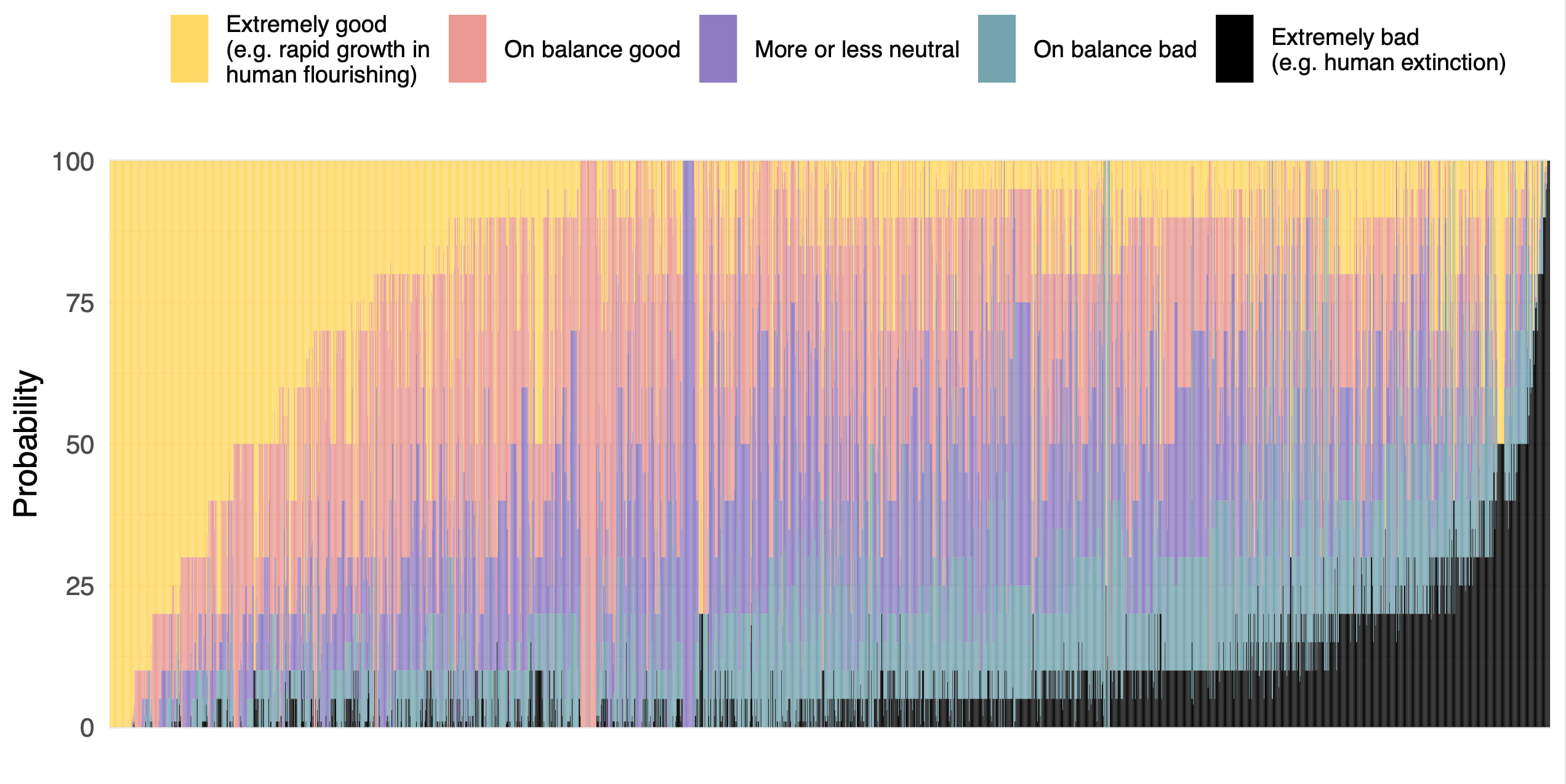
Preferred rate of progress
What rate of global AI progress over the next five years would make you feel most optimistic for humanity's future? Assume any change in speed affects all projects equally.
Of the 675 responses to this question,
4.8% said “Much slower”
29.9% said “Somewhat slower”
26.9% said “Current speed”
22.8% said “Somewhat faster”
15.6% said “Much faster”
How soon will 39 tasks be feasible for AI?
Participants were asked about when each of 39 tasks would become “feasible” for AI, i.e. when “one of the best resourced labs could implement it in less than a year if they chose to. Ignore the question of whether they would choose to.” Each respondent was asked about four of the tasks, so each task received around 250 estimates.
As with the questions about timelines to human performance, participants were asked for three year-probability pairs with either the fixed-years or fixed-probabilities framing. Out of the 32 tasks which were also in the 2022 survey, for most of them the aggregate forecasts in this survey predicted them to be reached earlier than was predicted in the 2022 survey.
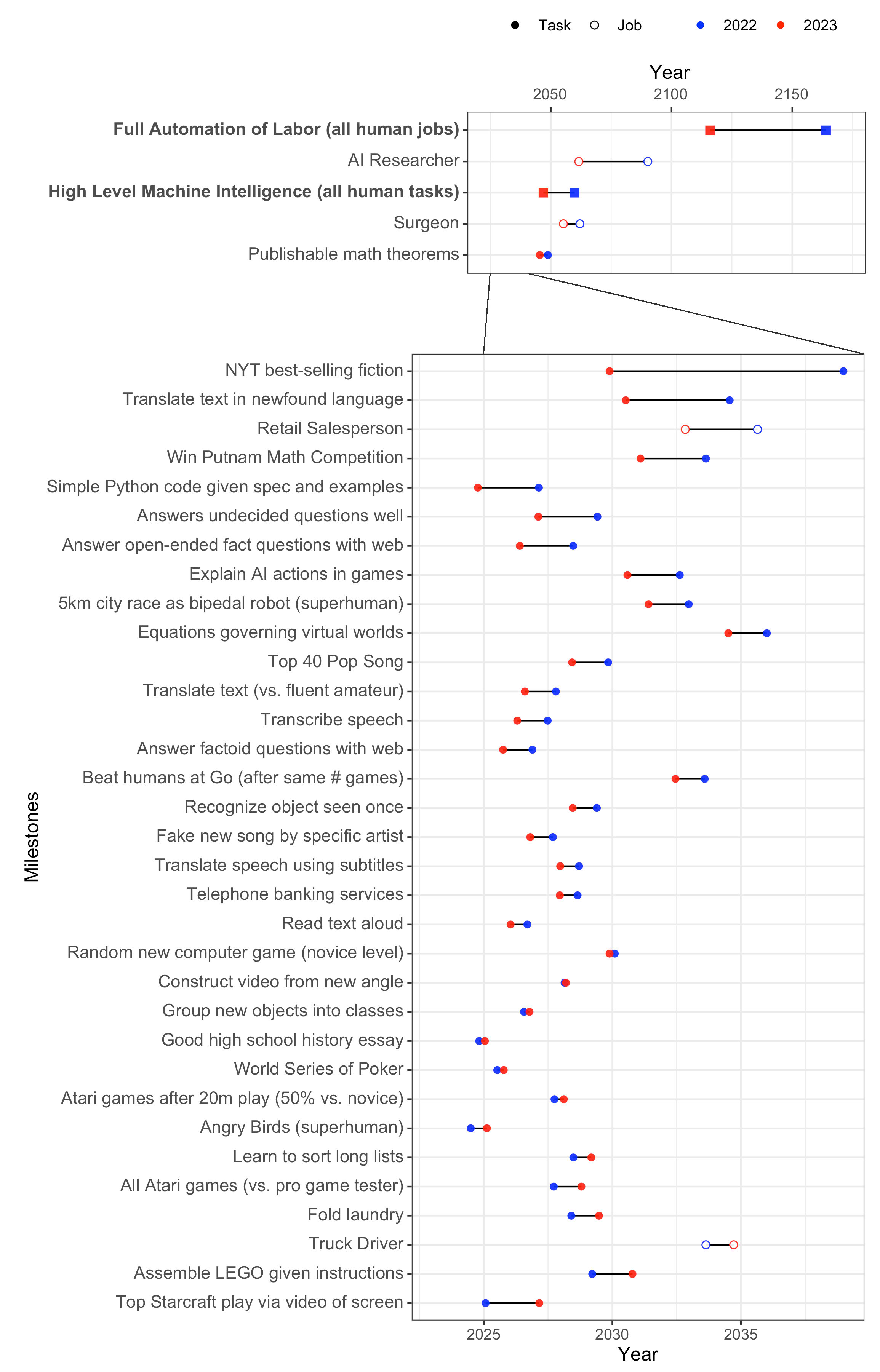
The alignment problem
Stuart Russell summarizes an argument for why highly advanced AI might pose a risk as follows:
The primary concern [with highly advanced AI] is not spooky emergent consciousness but simply the ability to make high-quality decisions. Here, quality refers to the expected outcome utility of actions taken […]. Now we have a problem:
1. The utility function may not be perfectly aligned with the values of the human race, which are (at best) very difficult to pin down.
2. Any sufficiently capable intelligent system will prefer to ensure its own continued existence and to acquire physical and computational resources – not for their own sake, but to succeed in its assigned task.
A system that is optimizing a function of n variables, where the objective depends on a subset of size k<n, will often set the remaining unconstrained variables to extreme values; if one of those unconstrained variables is actually something we care about, the solution found may be highly undesirable. This is essentially the old story of the genie in the lamp, or the sorcerer’s apprentice, or King Midas: you get exactly what you ask for, not what you want.
"Do you think this argument points at an important problem?"
Of the 1322 who answered this question,
5% said “No, not a real problem”
9% said “No, not an important problem”
32% said “Yes, a moderately important problem”
41% said “Yes, a very important problem”
13% said “Yes, among the most important problems in the field”
"How valuable is it to work on this problem today, compared to other problems in AI?"
Of the 1321 who answered this question,
9% said “Much more valuable”
22% said “More valuable”
39% said “As valuable”
22% said “Less valuable”
8% said “Much less valuable”
"How hard do you think this problem is compared to other problems in AI?"
Of the 1274 who answered this question,
21% said “Much harder”
36% said “Harder”
30% said “As hard”
10% said “Easier”
3% said “Much easier”
How much should society prioritize AI safety research?
Let 'AI safety research' include any AI-related research that, rather than being primarily aimed at improving the capabilities of AI systems, is instead primarily aimed at minimizing potential risks of AI systems (beyond what is already accomplished for those goals by increasing AI system capabilities).
Examples of AI safety research might include:
- Improving the human-interpretability of machine learning algorithms for the purpose of improving the safety and robustness of AI systems, not focused on improving AI capabilities
- Research on long-term existential risks from AI systems
- AI-specific formal verification research
- Developing methodologies to identify, measure, and mitigate biases in AI models to ensure fair and ethical decision-making.
- Policy research about how to maximize the public benefits of AI
How much should society prioritize AI safety research, relative to how much it is currently prioritized?
Of the 1329 responses to this question,
2% said “Much less”
6% said “Less”
22% said “About the same”
36% said “More”
34% said “Much more”
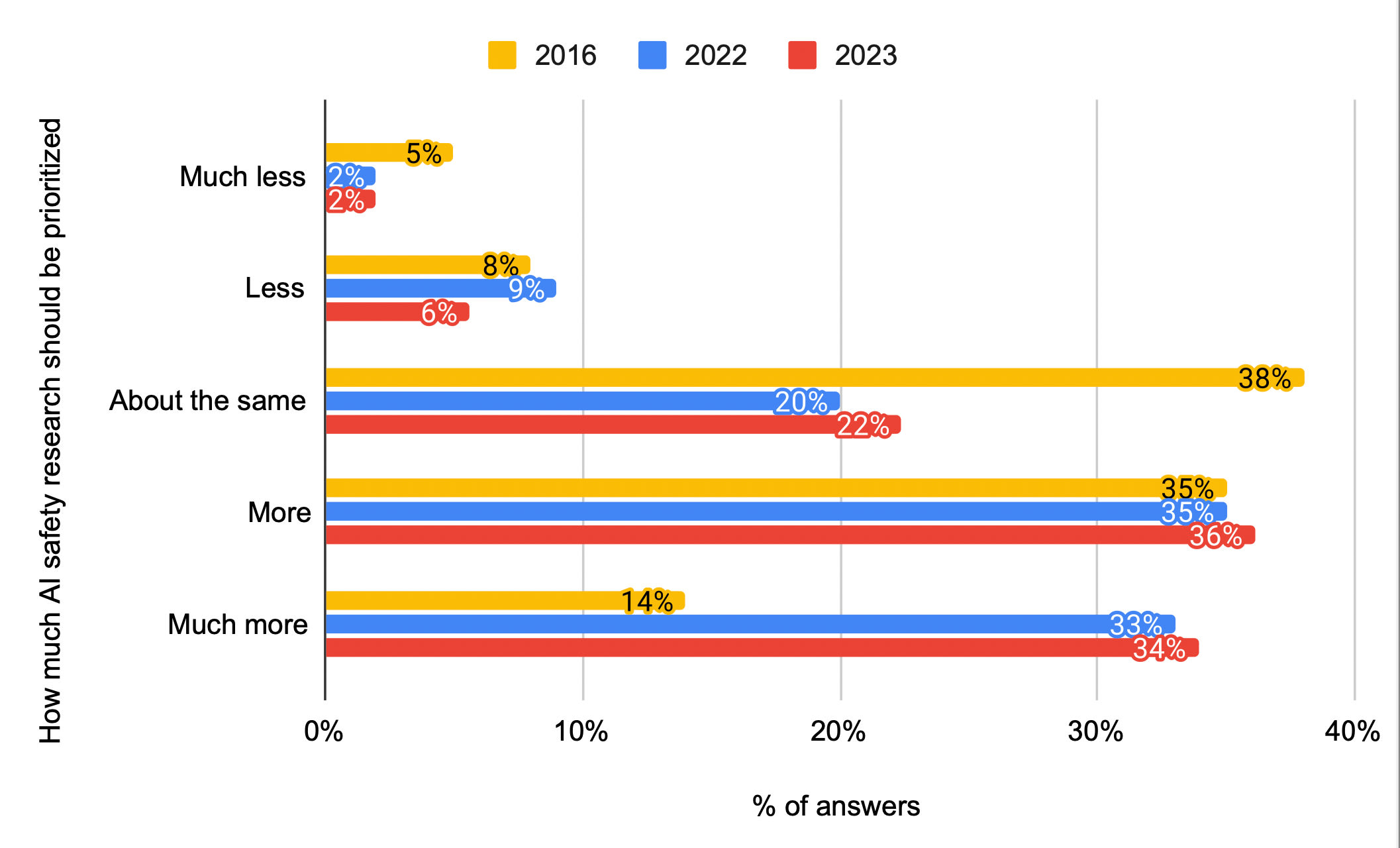
Human extinction
We asked about the likelihood that AI will cause human extinction using three differently phrased questions, for which we collected 655-1321 responses each.
| Question phrasing | Median response | Mean response |
|---|---|---|
| “What probability do you put on future AI advances causing human extinction or similarly permanent and severe disempowerment of the human species?” | 5% | 16.2% |
| “What probability do you put on human inability to control future advanced AI systems causing human extinction or similarly permanent and severe disempowerment of the human species?” | 10% | 19.4% |
| “What probability do you put on future AI advances causing human extinction or similarly permanent and severe disempowerment of the human species within the next 100 years?” | 5% | 14.4% |
2 comments
Comments sorted by top scores.
comment by Jonas V (Jonas Vollmer) · 2024-01-07T12:35:17.225Z · LW(p) · GW(p)
Does anyone know if the 2022 survey responses were collected before or after ChatGPT came out?
Replies from: jeffrey-heninger↑ comment by Jeffrey Heninger (jeffrey-heninger) · 2025-02-07T19:28:17.600Z · LW(p) · GW(p)
Before. The 2022 survey responses were collected from June-August. ChatGPT came out at the end of November.

